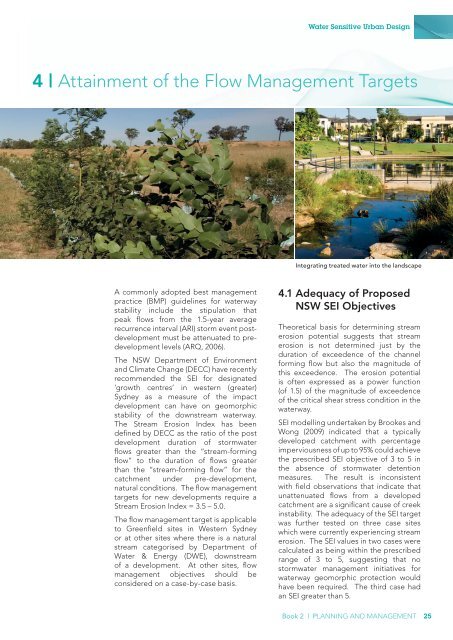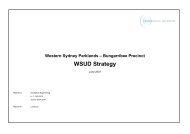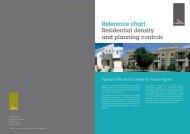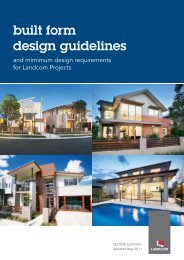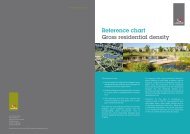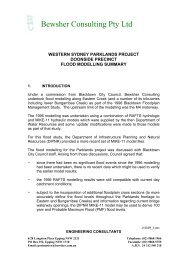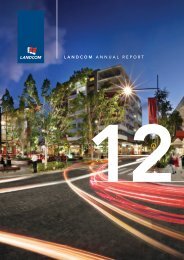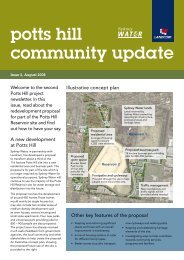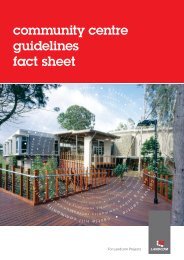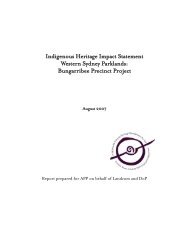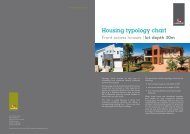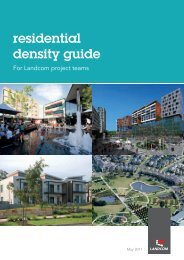Water Sensitive Urban Design
Book 2 | Planning and Management - WSUD
Book 2 | Planning and Management - WSUD
- No tags were found...
Create successful ePaper yourself
Turn your PDF publications into a flip-book with our unique Google optimized e-Paper software.
<strong>Water</strong> <strong>Sensitive</strong> <strong>Urban</strong> <strong>Design</strong><br />
4 | Attainment of the Flow Management Targets<br />
Integrating treated water into the landscape<br />
A commonly adopted best management<br />
practice (BMP) guidelines for waterway<br />
stability include the stipulation that<br />
peak flows from the 1.5-year average<br />
recurrence interval (ARI) storm event postdevelopment<br />
must be attenuated to predevelopment<br />
levels (ARQ, 2006).<br />
The NSW Department of Environment<br />
and Climate Change (DECC) have recently<br />
recommended the SEI for designated<br />
‘growth centres’ in western (greater)<br />
Sydney as a measure of the impact<br />
development can have on geomorphic<br />
stability of the downstream waterway.<br />
The Stream Erosion Index has been<br />
defined by DECC as the ratio of the post<br />
development duration of stormwater<br />
flows greater than the “stream-forming<br />
flow” to the duration of flows greater<br />
than the “stream-forming flow” for the<br />
catchment under pre-development,<br />
natural conditions. The flow management<br />
targets for new developments require a<br />
Stream Erosion Index = 3.5 – 5.0.<br />
The flow management target is applicable<br />
to Greenfield sites in Western Sydney<br />
or at other sites where there is a natural<br />
stream categorised by Department of<br />
<strong>Water</strong> & Energy (DWE), downstream<br />
of a development. At other sites, flow<br />
management objectives should be<br />
considered on a case-by-case basis.<br />
4.1 Adequacy of Proposed<br />
NSW SEI Objectives<br />
Theoretical basis for determining stream<br />
erosion potential suggests that stream<br />
erosion is not determined just by the<br />
duration of exceedence of the channel<br />
forming flow but also the magnitude of<br />
this exceedence. The erosion potential<br />
is often expressed as a power function<br />
(of 1.5) of the magnitude of exceedence<br />
of the critical shear stress condition in the<br />
waterway.<br />
SEI modelling undertaken by Brookes and<br />
Wong (2009) indicated that a typically<br />
developed catchment with percentage<br />
imperviousness of up to 95% could achieve<br />
the prescribed SEI objective of 3 to 5 in<br />
the absence of stormwater detention<br />
measures. The result is inconsistent<br />
with field observations that indicate that<br />
unattenuated flows from a developed<br />
catchment are a significant cause of creek<br />
instability. The adequacy of the SEI target<br />
was further tested on three case sites<br />
which were currently experiencing stream<br />
erosion. The SEI values in two cases were<br />
calculated as being within the prescribed<br />
range of 3 to 5, suggesting that no<br />
stormwater management initiatives for<br />
waterway geomorphic protection would<br />
have been required. The third case had<br />
an SEI greater than 5.<br />
Book 2 | planning and management 25


